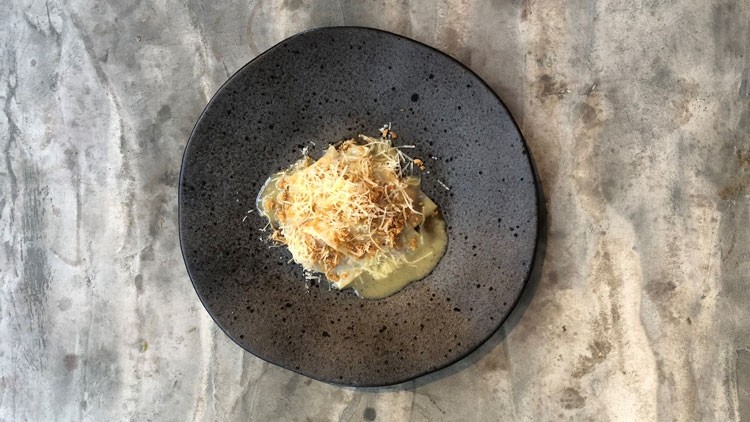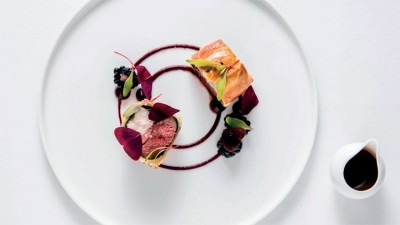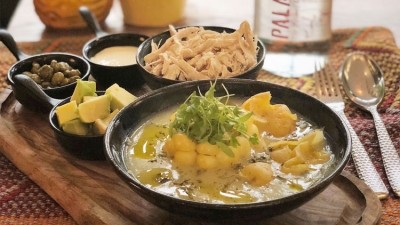Chef masterclass: Squirrel lasagne by Native's Ivan Tisdall-Downes

One of gastronomy’s fiddliest jobs, as many chefs and ambitious home cooks will confirm, is French trimming a rabbit: carefully boning the carcase to end up with a perfect saddle, either on the bone, its ribcage cleaned as scrupulously as a rack of lamb, or boned, skin on, to be rolled and stuffed as a ballotine.
Just don’t try the same procedure with a squirrel. The musculature is similar to a rabbit’s, but it is about a quarter the size. Fortunately, as Ivan Tisdall- Downes, chef-patron at Native near Borough Market, has discovered, there is a much easier way to separate meat and bone.
He removes the offal – he uses it for Native’s game parfait – then braises the squirrel carcasses with root vegetables and aromatics until tender, picking the meat from the bones when the braise has cooled a little. The haunches – the back legs – have the most meat. The cooking liquor is strained and used as the stock in a ragù.
Grey squirrel is an invasive species. “It was introduced to Britain in the 19th century, and numbers have risen to nearly five million,” says Tisdall-Downes. The number of native red squirrels, by contrast, which are smaller and have a lesser capacity for storing fat over the winter, had (by 1995) dwindled to 161,000. “It’s a highly sustainable and delicious meat with a light gamey flavour and a delicate nuttiness. I think it will start to appear on many more menus,” he says.
Resourceful southerners in the US have eaten squirrel for centuries, notably as the main ingredient in Brunswick stew, a traditional dish with a tomato base, beans and vegetables, to which both the city of Brunswick, in Georgia, and Brunswick County, Virginia, lay claim, although another theory suggests that the stew – to which Queen Victoria was apparently very partial – actually comes from Germany, its name a corruption of Braunschweig, a city in Lower Saxony. Older recipes call for rabbit, squirrel or opossum, often stewed with lima beans, corn and okra, although modern versions tend to favour chicken or pork.
Tisdall-Downes’ ragù lends itself perfectly to pasta, either tossed with pappardelle, the wide pasta ribbons from Tuscany that are often used as a foil for wild boar or hare, or – in a lighter version that he serves at Native – made into an open ‘lasagne’, using lightly cooked sheets of celeriac instead of pasta. He slices the peeled celeriac on a mandolin, blanches the thin sheets in boiling water for a minute, then stirs them gently in a pan with melted butter until al dente, before layering them with the hot ragù on the plate.
Pickled walnuts add a piquant note; ricotta – he makes his own, curdling milk with cider vinegar – the Parmesan-like Lincolnshire Poacher, and a sprinkle of pangrattato give the dish an Italian resonance. “I like to present game in a way that everyone’s familiar with,” he says.
Native’s squirrels are often shot by the same hunters who deliver the restaurant’s venison, but they can be bought online from Season’s in Staffordshire (www.naturalgame.co.uk) or Suffolk’s Wild Meat Company (www.wildmeat.co.uk) for around £5 each.
Tisdall-Downes is one of a growing number of chefs who sees game (and vermin, in the case of both rabbits and squirrels) as an important and neglected source of protein. While restaurant customers might be wary of an unfamiliar meat like squirrel, they can be reassured that it is low in fat and very healthy to eat. Squirrels lives off the land, have a varied diet, get plenty of exercise, and don’t touch drugs. As animals go, they are irreproachably clean-living.
Squirrel lasagne
Ingredients (serves 4-6)
For the squirrel
4 grey squirrels, paunched and skinned, about 1kg in total
1 medium sized carrot, roughly chopped
1 onion, skin on, roughly chopped
2 cloves of garlic, chopped in half
4 juniper
Sprig of thyme
1 bay leaf
Small bunch of parsley stalks
For the ragù
3 tbsp light olive oil
200g carrots, finely diced
200g onions, finely diced
3 cloves garlic, finely chopped
1 heaped tbsp capers
1 tsp fennel seeds
1 tsp demerara sugar
1 tbsp tomato purée
25ml cider vinegar
100ml red wine
250ml squirrel stock (the strained cooking juices, reduced to 250ml if necessary)
400g chopped tomatoes
1 tsp dried marjoram
Salt and pepper
1 tbsp chopped parsley
To serve, per portion
2 pickled walnuts, sliced
1 tbsp ricotta
3 or 4 celeriac sheets (see text)
15g Lincolnshire Poacher, finely grated
1 tbsp breadcrumbs fried in butter (pangrattato)
Method
1. Heat the oven to 150°C. Clean the squirrel and remove any offal. Place in a deep pan and cover with water. Cover the pan and braise for 3 hours, or until the meat separates easily from the bone.
2. When cool enough, pick the meat from the bones and reserve. Strain the cooking liquid through a sieve and reserve as well.
3. In a frying pan, heat the oil and add the carrots, onions, garlic and capers. Season with salt and pepper and cook over a medium heat until softened and lightly browned. Add the sugar and fennel and cook until the sugarbegins to caramelise, then add the tomato puree. Cook for 3 minutes longer, then deglaze the pan with the vinegar, add the red wine and reduce by half.
4. Add the tinned tomatoes, squirrel meat, squirrel stock and dried marjoram and reduce until the sauce is thick enough to coat the back of a wooden spoon. Season to taste and finish with freshly chopped parsley.
5. To serve, spoon the ricotta into the middle of a warmed plate, scatter with the pickled walnut slices, then spoon some ragù on top and drape a sheet of celeriac over it. Continue this process, with two or three layers more of celeriac and ragù, finishing with ragù and then topping with the Lincolnshire Poacher and the pangrattato.
















